IT'S BACK! (finally) The 2.5# dbl boot! The
Scarpa Phantom 6000

I know, I know, it only took 30 years but we are finally back to a double boot that excels on technical climbing and that weighs in at a svelte 2# 10oz in my size 12 (46) feet. (Poetic license and a cleaner intro on the 2.5# since my size 12s won't make that number. )
I can drop a full pound off my size 12 feet by using these boots!
That is 6.5 off my back by the theory. But do they fit? And how do they climb?
If you missed my previous bitch fest blog post I had been laughing at how both
Sportiva and
Scarpa...and any one else in the business for that matter...had not yet equaled let alone duplicated the warmth, climbing ability and weight of the 1980
Kolfach Ultra @ 2# 10oz with an
Aveolite inner boot. Kinda sad that even though the boots were now in the $700 range. (Buyer hint: wait, be patient and hunt around. If you do not unusual that you can buy any of them on sale for $500 or less. The 6000 went on sale for $70 off retail before I even got the review written! The Internet price for a pair of
Spantiks can be as low as $500 from what I have seen.)
Boot weights (Euro size 45 or 11.5/12 US)
La
Sportiva Spantik 3# .o5oz
La
Sportiva Baruntse 3# 2.5oz
La
Sportiva Batura (winter single boot) 2# 7oz
Kolfach Ultra w/
Aveolite liners 2# 10oz (vintage 1980)
Scarpa Phantom 6000 2# 10oz
Scarpa Phantom Guide (winter single boot) 2# 7.5oz
I am told the newest boots have sex appeal galore, technology that may or may not work and fit that could go from perfect (and just as likely from reports I get) to dismal.
At the risk of repeating myself here let me back up once again. Super Gators were very good in cold weather. Plastic boots for the most part negated their use and when required out came the neoprene full over boots as the temps dropped. Never the best answer for technical climbing because of crampon fit/or no fit many just do without and risk the cold injury.
The old Phantom 6000 and the
Spantik addressed the issues in different ways but basically boots that did not require another add on gaiter to keep your feet warm enough up high and out in the cold.
After seeing the newest versions of the synthetic double boots I have long thought that to gain the warmth we all generally need the boots have gotten too big physically and the fit hasn't gotten any better compared to the older leather double boots.
My preference would be a dbl boot with slightly less volume than the
Spantik or the
Baruntse, equally as warm and all the while dropping some weight in the process. A warm dbl boot suitable for hard technical climbing made of modern material should be able to get under 2 and 1/2 pounds in my size 12s. With a over-all outside volume closer to the old
Koflach and
Asolos would be well received by many needing a warm dbl boot. The most modern technology and materials should be able to make a boot of that volume, warmer and lighter that the earlier plastic boots.
One stainless
Sabertooth, no bots with
Petzl bails 14.2 oz
One Phantom 6000 2# 10oz
Total weight per combo is 3# 8.2oz.That number betters my 30 year old gold standard of 3# 9oz. of
Kolfach Ultra and
Chouinard hinged with straps.
Add the need for a real gaiter and different
sox weights for the
Kolflach and the actual weight savings is even more, or what would have been 9oz or more per foot in my 45s. And a big advantage in climbing ability and warmth with the new
Scarpa 6000.
Among other things the over all volume of the boot should give us a clue on the warmth of the boot but so does the quality of the insulation, how dry the insulation stays on the interior, sole insulation and what is keeping the exterior upper dry and clear of snow.
 Dbl click on the picture and take a look at the Guide on the right and the 6000 on the left in the picture. The mid sole and lugs are thinner on the 6000. Heel has less material as well. The mid sole on the 6000 is totally different between the two models of boot.
Dbl click on the picture and take a look at the Guide on the right and the 6000 on the left in the picture. The mid sole and lugs are thinner on the 6000. Heel has less material as well. The mid sole on the 6000 is totally different between the two models of boot. The synthetic materials allow the current boot builders to keep the outer shells dry. But until now a gaiter of some sort is usually required. Several older leather single and dbl boots have had attached gaiters, San Marco,
Fabino and
Trappeur comes to mind off hand.
Scarpa has taken the 8000m technology of a fully integral
gaitor that One Sport invented in the '80s and added it to lighter weight boots while making them warmer yet.

The Scarpa Phantom line obviously has a built in, insulated outer/super gaiter that is sealed with a water proof zipper (the TIZIP) and a button snap closure in an elastic top. It is not Scarpa's first zipper rodeo. This is 2nd and maybe 3rd generation on their gaiter and zipper for the Phantom line. And they have continued to made improvements. This version is stout. Stout enough that La Spotiva copied them and are now using the same brand "TIZIP" water proof zipper for their Batura. Simple and effect. But it is still fabric and a zipper so not terribly durable in comparison to some of the old school style boots, a Nepal Evo or Scarpa Mt. Blanc as examples. Scarpa also wisely includes the special TIZIP zipper lube for its maintenance.
Let me discuss durability a bit. Many of the very best cold weather boots do two things to eliminate weight and make the boots warmer. They use a hard foam insole/midsole to help insulate from the ground up. They also make the lug pattern and sole as thin as possible, again to save weight. Scarpa uses both techniques on the 6000 and I think to good effect on this boot.


Neither technique adds durability to the boot. Put a fabric gaiter/outer surface on the boot and you have to start thinking high performance as a cost for long term durability. The nylon material used won't shed a crampon or a sharp rock for that matter. For a boot that will generally be used with crampons and on snow and ice the majority of time they should last "long enough". But they won't last as long as some of the newest synthetic dbls available. Baruntse comes to mind as the the more durable boot of the three discussed here. In my size the cost of durability is an extra full pound on my feet. But is there a difference in warmth between the Scarpa 6000 and the La Sportive flag ship, technical, dbl boots? That observation will have to wait till December I suspect. But it is going to have to be really cold (-20C and below) to feel a difference is my thought on it. If anything I have learned from using Primaloft 1 garments that thickness of the insulation these days doesn't always give you a relative idea of how warm the garment might be in actual use. And the Scarpa 6000 uses Primaloft to insulate the outer boot. Hope for the best....plan for the worst and know your own limitations when it comes to cold feet.
The Scarpa 6000 is a lower profile and more sensitive boot than the Spantik or the Baruntse. The sole and ankle flex are somewhere between the Spotiva models. Defiantly not as stiff of flex as the Spantik...more akin to the Baruntse. It will be a great technical boot on hard terrain and stiff enough for the endless 60 degree alpine ice suffer fests IF you are accustomed to the newest flexable fabric boots. It is better compared to the La Sportiva Batura and the Scarpa Phantom Guide single boots for volume and weight. You can get an idea by that comparison on how they will be on mixed :)
Hard for me to talk about any boot without making comparisons. My current dbl boots are the Spantik, Baruntse and now the 6000. By far the worst fitting inner boot for me is the Spantik. The best is the easily heat formed Baruntse inner boot. The new 6000's inner boot is obviously intended to be a VBL inner boot worn with only a thin sox. The Velcro seals the inner up tightly. Not sure about the extra bumps on the inner boot though and comfort long term. The entry system also makes it a bitch to put on and take off the inner. That entry and the surface finish of the foam inner makes it hard to get in and out of the shell as well. The Spantik's inner is fairly traditional and a lace up. My experience is that the Spantik's eyelets are not durable on the inner or outer boot. The Baruntse has a more modern lace system on the inner. Hard to break or have a failure in that inner boot. The Baruntse is the easiest of the three to use and the most durable. It is the inner I think the Spantik should have been delivered with. It fits better and is lighter in weight. The lace system more closely mimics the Spantik shell system as well but no durability issue. Nice that my Baruntse inner will fit any of the 6000 outer boot. IMO the Baruntse inner is the best of the three for fit and ease of use. It weighs only 1/2 oz more (@6 oz) than the 6000's inner (5.5oz). The Spantiks' inner boot weights 9.0oz.
6000's Velcro sealed, VBL inner boot, and removable foam insoleThe 6000's inner boot? Sadly nothing good to talk about here
imo. The inner is a bitch...really a bitch... to get into. Part of that is the majority of the inner boot is unlined closed cell foam. Yes, unlined foam. Bare feet and most
sox will stick to the foam trying to put them on and take them off. This inner wouldn't last me one 3 week Alaska trip. I would
shred it in short order even while trying to be careful. I don't doubt it is very warm......and high tech.....but durable it ain't going to be. And that 44 size insole? Yes my 45s came with a 44 size insole in the inner boot. And the inner boot fits
like a 44 as well. My guess? By the fit with this inner boot in place is the 6000 will fit one full size too small. I had actually ordered a 46 the day these arrived just to cover the bases...played with my
Baruntse inner boot in the outer boot and decided the 45s would NOT work for me. I ended up with a 46s. The 45 Guides fit OK although a bit narrow in the toe.

There is really only one reason to climb in a dbl. boot. It isn't the warmth generally. Get the right single boot and keep them dry inside and out and you can deal with some terribly cold temps. The problem is doing it day after day and keeping your boots dry in and out and unfrozen. A dbl. boot is the only thing that will allow you to keep your boots dry on the inside because you can dry them in your bag at night as well as keep them from freezing. So the added warmth is great but the real reason is dry boots. Dry boots and dry
sox means warm feet. No one actually enjoys climbing in double boots (any of them) ...they are all huge and they are all heavy. But way less stress in the cold mountains...with a good double boot.


Of the three boot shells the
Baruntse is the only traditionally laced outer boot. Simple and effective system to get a good fit in that boot. Very durable and reliable. From my limited experience if you have problems with fitting boots the
Baruntse is the boot most likely to fit. Still it can take 3 men and a boy to lace them tight enough. The
Spantik has a lace system you either love or hate. I can't get my ankle tight enough without some serious effort. Too much effort in really cold conditions where the system should make things easier. Sper thin laces are rough on your hands. Inner and outer eyelets are fragile. I personally went through three pair of Spamtiks before having a "solid" pair now. Because of the lacing issue I end up with heel lift in the
Spantik if I am not extremely careful adjusting the laces. Get tired and cold and not adjust the boots perfectly and I'll get heel lift going up and toe bump going down in the
Spantik. So I am on the hate side of that discussion. Boots do climb well though....so I have used them on things that are cold and challenging for me.
The 6000 has an interesting lace system. My old Koflach inners were a slip on with only a Velcro strap across the top locking the tongue in place. On the 6000 you lace the outer shell to one eyelet above the angle and it locks with a mechanical lace lock...sweet system btw and very easy to use even cold or tired from what I can see so far. (see the pictures for details on the lock) By far the easiest of the three outer boots to lace tightly. It really is trick and so far if my Guides are an example the lock system is durable/reliable as well. Above the lace system is a single Velcro "power band" strap that closes the rest of the outer shell. It also controls just how stiff the boot will be and how much heel hold down you'll have by how tight you wrap that strap. Easy to go over board on either lace system and really crank the 6000 down, till it is way too tight. For me that says I'll be able to get it tight enough in the mountains when required. And it is really easy to do. A lot less toe bump or heel lift as the end result. I'm stoked on that! Velcro does wear out...but not quickly and it will be easily replaceable on this strap. But there is a lot of Velcro (1" x 4") and I suspect the boots will be toast before you have to replace the 1" x 4" hook and 1" x 4" loop that mates up on the "power strap".



Toe bump? Generally toe bump is either a too small of boot or not a tight enough boot. When I first tried the 6000 on I had just gotten off a 5 mile ridge traverse with another couple of miles of walking so I had some pretty swollen feet. I thought the sizing was at least a full size too small. Turns out I wear a 45 from Sportiva and a tight 45 in the new Scarpa Guide and a 46 in the 6000.
As I reviewed this post I was looking at the pictures and noted that the insole of the inner boot that I have flipped over in the picture above is marked "44". Sneaky bastards......... When I first pulled the 6000 out of the box it took me 10 seconds flat to figure out I didn't like the Scarpa inner boot so I didn't look at it very closely or try to get a decent fit in it. I just stuck my "go to" Baruntse inners in the shells..thinking I was set. The 6000's actual inner boot and the shells are both marked 45. But common in the dbl boot arena to not offer true half sizes and cheat on the sizing in general. My thought? Bastards! Trust no one, try the boot (any boot) on in person, verify your exact size with the liners and sox you intend to use.

Frankenstein? Both the Spantik (more so) and the Baruntse make me feel like I am walking on stilts. I gain almost a full inch in height. I am willing to put up with that because I know that the sole insulation is much of what keeps your feet warm in really cold conditions with crampons. It doesn't help my technical climbing though. You'll feel the difference on the 6000 and if you look at the photos you'll see the difference...almost a 1/2" less in sole thickness between the Spantik and the 6000 in some areas on the sole. I measured anywhere from .25" to .45" difference in total sole thickness between the two.

One of the interesting details I found on the 600 is the sole. No only are the lugs smaller and less of them than the single boot, Phantom Guide, but they have a totally different sole pattern. La Sportiva has taken good advantage of this idea as well. Where I really noticed it was in the La Sportiva Trango Series. They use sticky rubber and a technical sole pattern that can really enhance rock climbing.
The 6000 is on the left again. Check out the toe rubber on the 6000 compared to the full lug pattern on the Guide. I would have thought it would be reversed. But I am not complaining! A dbl boot that will out climb a single boot? And only 3 oz heavier? Hard to believe actually. Even ditching the original liner I am happy enough with the obvious advantages and fit of the 6000 shell that I will be using them next winter and spring. The real question is how will they hold up over a full years use? Check back for an answer on that one.
Crampons?
A good fit on the 6000 with the BD Sabertooth 'pons, BD asymetrical connecting bars and Petzl front bails.

Bill Belcourt @ Black Diamond is a smart guy, who climbs hard. He also oversees the climbing hardware dept. @ BD. So while were were both "wowed" by the weight of the 6000 at last winter's OR show he was wondering then about how the super low profile Scarpa soles on the new Phantom line would work with the BD crampon bindings. Rightfully so imo. The Phantom guide seemed to pose little problem with my hybred BD Sabertooths useing Petzl front bails and a the BD asymetrical connecting bar. But the 6000 is a jump on even the Guide's sole profile....as in a thinner and smaller profile toe. My BD Sabertooths do still work OK but my Patzl Darts and Dart Twins don't fit well at all...surprizing as I had understood Ueli Steck (Petzl sponsored) had some involvement in the boot design. So plan on having some time/effort/possible new parts for your crampons if you decide to go to the newest Scarpa boots.
Close up photo of a terrible fit, stock Petzl Dartwin 'pons on the front of the 6000.

Sabertooth with the optional aluminum Neve' heel and the asymetrical bars.

And as of tomorrow my goal will be to own only two pair of dbl boots. I''ll let you guess which two.
Scarpa's spiel:
And be sure to note the one year warranty
"Give your foot a warm and sturdy platform to help you crush your next winter ascent when you lace and zip it up inside the Scarpa Phantom 6000 Mountaineering Boot. This fortress of warmth features a built-in zip-up gaitor for sealing out the skin-searing cold and a waterproof liner so your feet stay dry even on slushy snowfields in late May.
•The tough S-tech upper’s rubber rand holds up to the abuse any frozen mountain dishes out
•Toe and heel plastic rands secure your crampons as you begin a climb into the heavens
•Waterproof liner is beefed up with a layer of EVA foam and heat-reflective aluminum to keep the warm air inside
•Insole and midsole cushion your steps while staying sensitive enough to feel each foothold before you take the next
•Vibram Mulaz outsole grips the rocks and snow as you approach the icefall
•Ergofit System stretches in the ankle for a dynamic fit for aggressive ice climbers and mountaineers
•Removable Mountain Lite liner lets you dry the sweaty liners in your sleeping bag on longer expeditions to keep them fresh and unfrozen
Material:
Shell: S-Tech (Cordura w/ 10% elastane)
Lining:Waterproof-OD, Lorica, 5mm EVA, heat-reflective aluminum
Removable Liner:Yes Sole:
Insole: Pro-Fiber XT;
Midsole: PU, microporous EVA;
Outsole: Vibram Mulaz
Crampon Compatible:Yes, very low profile toe welt
Lacing:Lace-pull on lower boot, single strap velcro closure on upper boot
Zip-up gaitor
Weight:[Pair, size 42] 4lb 6oz (2000g)
Recommended Use:Ice climbing, alpine climbing, mountaineering
Manufacturer Warranty:1 Year
 Camp Muir was a popular place this weekend, perhaps because the weather was so good and all of the extra promotion on this blog. On Saturday, there was a steady cadence of day hikers, climbers and skiers/boarders ascending the snowfield to give mountain-type praise to Rainier. Most, it seemed, left the park quite satisfied.
Camp Muir was a popular place this weekend, perhaps because the weather was so good and all of the extra promotion on this blog. On Saturday, there was a steady cadence of day hikers, climbers and skiers/boarders ascending the snowfield to give mountain-type praise to Rainier. Most, it seemed, left the park quite satisfied. The important take-home news is that climbing the Disappointment Cleaver is over, for now... Most teams are reaching the summit from Camp Muir via the Emmons Glacier. This involves dropping climbers right from Ingraham Flats and traversing below the Cleaver onto the Emmons Glacier. There are some pros and cons to this "new" and longer route, but my thoughts are that this variation will come as welcome news to most of you. First off, the the route is quite scenic. Moreover, it doesn't include the DC rock scramble and avoids that wild crevasse network above the cleaver that appeared to me to be an accident waiting to happen.
The important take-home news is that climbing the Disappointment Cleaver is over, for now... Most teams are reaching the summit from Camp Muir via the Emmons Glacier. This involves dropping climbers right from Ingraham Flats and traversing below the Cleaver onto the Emmons Glacier. There are some pros and cons to this "new" and longer route, but my thoughts are that this variation will come as welcome news to most of you. First off, the the route is quite scenic. Moreover, it doesn't include the DC rock scramble and avoids that wild crevasse network above the cleaver that appeared to me to be an accident waiting to happen.  Thank you Paul Charlton for stepping in yesterday... Photos by Mike Gauthier. 1. Bob Murphy crossing a crevasse near 12,400 feet above the DC; 2. Climbers approaching Ingraham Flats; 3. Gapping crevasses above the sea of clouds, as viewed from new Emmons variation of the DC route.
Thank you Paul Charlton for stepping in yesterday... Photos by Mike Gauthier. 1. Bob Murphy crossing a crevasse near 12,400 feet above the DC; 2. Climbers approaching Ingraham Flats; 3. Gapping crevasses above the sea of clouds, as viewed from new Emmons variation of the DC route.
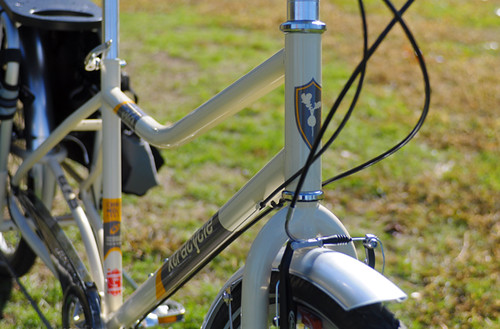


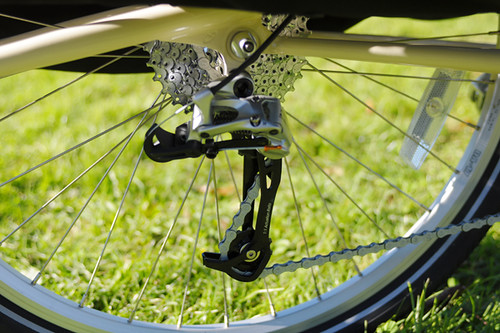
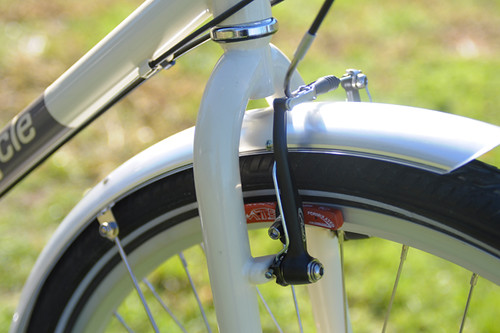

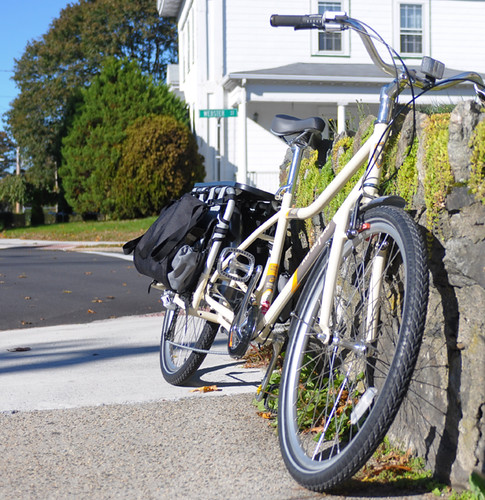






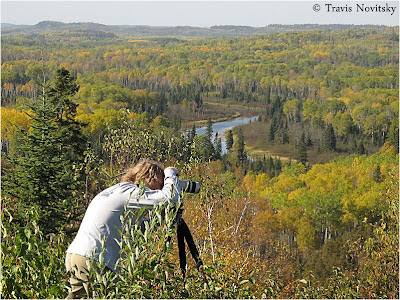











 On the trail to Willow Hole.
On the trail to Willow Hole. It was nice that someone showed me the way to go! One couple that I talked to on the way back thought that the trail ended here.
It was nice that someone showed me the way to go! One couple that I talked to on the way back thought that the trail ended here. And that dry river bed? Well, it wasn't really dry at all. Along the edges I noticed that the sand was darker. Digging into it with my hands confirmed that it was damp and going down a little further it was really wet. Further along the trail there was standing water in some spots. It was an unusual winter throughout most of the U.S., wet and cold. And that unusual winter has given us an unusual spring as well, with water showing up in places where it hasn't been for many years.
And that dry river bed? Well, it wasn't really dry at all. Along the edges I noticed that the sand was darker. Digging into it with my hands confirmed that it was damp and going down a little further it was really wet. Further along the trail there was standing water in some spots. It was an unusual winter throughout most of the U.S., wet and cold. And that unusual winter has given us an unusual spring as well, with water showing up in places where it hasn't been for many years. Willow Hole. A pool of black, brackish water.
Willow Hole. A pool of black, brackish water. This area was about a mile from Willow Hole. On my way in I had met a couple and we had talked for a while then they started back out. As I returned they were sitting on the two large rocks in the foreground with their feet soaking in the water. They said it was refreshing and asked me to join them, which I did. When I got my shoes and socks off and stuck my feet in the water, they laughed because I immediately pulled my feet out. The water was cold. Extremely cold. I was amazed and wasn't expecting that, but they were right, it was refreshing. We sat there for half an hour or more, talking and relaxing.
This area was about a mile from Willow Hole. On my way in I had met a couple and we had talked for a while then they started back out. As I returned they were sitting on the two large rocks in the foreground with their feet soaking in the water. They said it was refreshing and asked me to join them, which I did. When I got my shoes and socks off and stuck my feet in the water, they laughed because I immediately pulled my feet out. The water was cold. Extremely cold. I was amazed and wasn't expecting that, but they were right, it was refreshing. We sat there for half an hour or more, talking and relaxing. At the end of the trail. Done! Is my face flushed from the heat and sun or is it a reflection from that bright red shirt?
At the end of the trail. Done! Is my face flushed from the heat and sun or is it a reflection from that bright red shirt?
 The view as I was leaving Zion National Park this morning.
The view as I was leaving Zion National Park this morning. Earlier last week.
Earlier last week.

















